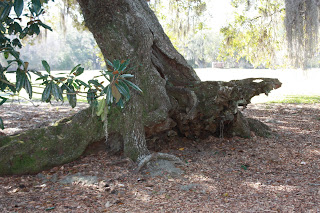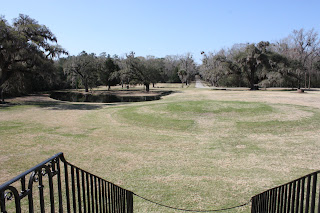Drayton Hall - near Charleston S.C.
Drayton Hall, 9 miles northwest of downtown Charleston on River Road, was one of the highlights of our recent road trip.
It is the oldest surviving example of Georgian Palladian archicture in the U.S.  The privy building seated 7. Think about it. There still is no indoor plumbing and the house was occupied into the 21st century. The last family member dropped extension cords from the nearby visitors building to run her refrigerator.
The privy building seated 7. Think about it. There still is no indoor plumbing and the house was occupied into the 21st century. The last family member dropped extension cords from the nearby visitors building to run her refrigerator.The well was a more recent addition that came after the rice fields had long gone.
The circles were a 3-tiered horse and buggy zone.
There are no gardens to visit ... yet
because the Trust is taking its time to study and reconstruct
the grounds to be historically accurate and the money to do large scale projects is being raised.
from the website -
Through the centuries, both the house and landscape have evolved, and while the house has remained substantially intact, the landscape has been transformed by hurricanes, earthquakes, wars, neglect, and changes in landscape styles. Furthermore, while a house is inert, a landscape is alive. New plants grow. Older plants die off. Fortunately, just as the main house is guided by a preservation philosophy to ensure that the layers of time and change are kept intact, so are the grounds. On the river-front lawn is the 18th-century ha-ha, the ditch that provided a nearly invisible barrier that kept large animals in grazing areas without disrupting the sweeping view. On the land-front lawn is the Victorian garden mound. A camellia planted about 1920 by Richmond Bowens, the descendant of seven generations of African Americans at Drayton Hall, survives as a key element of the gardens. This preservation approach to the landscape makes Drayton Hall exemplary among historic sites in the nation. According to Southern landscape historian Suzanne Turner, Drayton Hall has "the most significant, undisturbed historic landscape in America."
Visitors to the site today can explore various parts of the landscape through the River Walk along the Ashley River and the Marsh Walk along the salt-river marsh and the remains of 18th-century rice fields. A major initiative, The Heritage Landscape Project, seeks to tell a broader and deeper story of the people and place over time by taking advantage of these landscape assets. This project is made possible in great part thanks to a generous endowment established by Gail and Parker Gilbert of New York and Charleston.
Current Research - As part of Drayton Hall's 2006 Wood Family Fellowship, Carter Hudgins has begun to work with 18th- and 19th-century maps of the Drayton Hall property to understand the use and development of the surrounding landscape. The findings to date reveal an intricate arrangement of gardens, ditches, drains, and boundaries that reflect the manners in which John and Charles Drayton designed the site so that it operated as an interrelated whole, combining aesthetics with agriculture, water management, and plantation operations. Of special interest as evidence of this are several outbuildings, ditches, and water features not described in written records. In accordance with the Landscape Master Plan, we'll conduct future archaeological investigations at these sites to determine when and how they were used.
Well worth a visit when you are in that area!






Comments